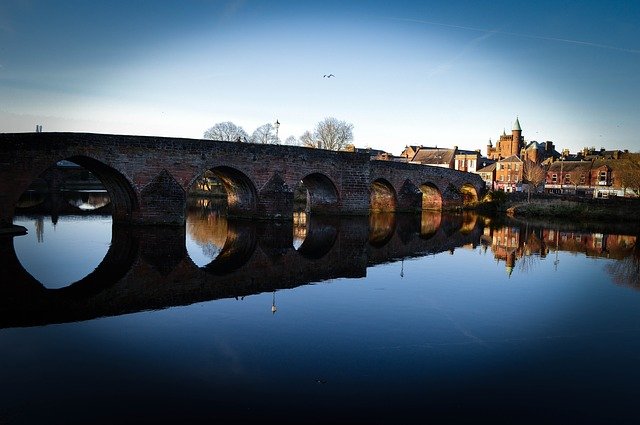By Tim Lambert
Early Dumfries
The Scottish king William the Lion made Dumfries a Royal Burgh in 1186. In the late 12th century a castle was built in Dumfries but it was demolished in the early 14th century. In 1395 Robert III gave Dumfries a charter. (In the Middle Ages a charter was a document granting or confirming the rights of a town). By then Dumfries was a flourishing market town. It was also an inland port. Wool and woolen cloth were exported from Dumfries and luxuries like wine were imported from France and Spain. Spices were also imported.
In Medieval Dumfries, there were the same craftsmen you would find in any town such as fleshers, skinners, glovers, shoemakers, and bakers.
However, because of its position near the border, Dumfries suffered during the conflicts with England in the 14th and 15th centuries. The English burned Dumfries several times. Dumfries also suffered an accidental fire in 1504.
In the 13th century, Franciscan friars arrived in Dumfries. Friars were like monks but instead of withdrawing from the world, they went out to preach. Franciscan friars were called grey friars because of the color of their costumes.
Devorgilla Bridge was first built in 1431. It was named after King John Balliol’s mother.
Through the years 1500-1800, Dumfries remained a busy market town. It was never a manufacturing centre although there was some leather tanning and shoemaking.
The Midsteeple was built in 1707 as a court and prison. Carved on it is an ‘ell’, an old measure for cloth. In 1959 a map of Dumfries as it was in the time of Robert Burns was added.
Dumfries gained its first newspaper in 1721. The Theatre Royal dates from 1787.
Robert Burns went to live in Dumfries in 1791. He died there in 1796. Robert Burns was laid to rest in the Burns Mausoleum in 1815.
Modern Dumfries
In the 19th century, Dumfries remained a market town for the surrounding area. It was still a busy port but in the 20th century, the port went into decline and eventually ceased altogether. In the 19th century, there was a tweed-making industry in Dumfries but it petered out in the early 20th century. In the 20th century industries in Dumfries included rubber, canned milk, knitwear, and hosiery.

Like all towns in the early 19th century, Dumfries was unsanitary. Dumfries suffered an outbreak of cholera in 1832. However, conditions in Dumfries improved in the later 19th century.
The existing Greyfriars Church was built in 1868. Also in 1868, Robert Smith was hanged at Dumfries. It was the last public hanging in Scotland.
A statue of Robert Burns was made in 1882 and Dumfries library was built in 1904. n In the 1920s and 1930 council houses were built in Dumfries. Many more were built after 1945. St Michael’s Bridge was built in 1927.
Dumfries grew rapidly in the 20th century. By 1951 the population of Dumfries was 26,000. In 2022 the population of Dumfries was 32,000.
Loreburne Shopping Centre opened in 1991. In 1997 Dumfries was voted the Best Place to Live in Britain. In 2023 the population of Dumfries was 33,000.

Dumfries is known as ‘Queen of the South’ (of Scotland).